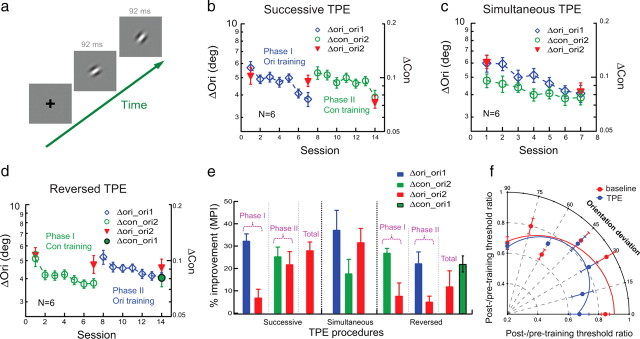Figure 1.

Perceptual learning of orientation discrimination and its transfer to a second orientation studied with TPE procedures. a, The stimulus configuration for orientation discrimination in which one interval contained a more clockwise Gabor stimulus. b, Successive TPE procedure. Phase I (sessions 1–7): orientation discrimination was practiced at one orientation (36°/126°, Δori_ori1, blue diamonds; orientation thresholds indicated by the left ordinate) and the transfer of learning was tested at an untrained orthogonal orientation (126°/36°, Δori_ori2, the left two red triangles), which replicated typical orientation specificity in orientation discrimination learning. Phase II (sessions 8–14): the same observers were later exposed to the transfer orientation ori2 in a contrast-discrimination learning task around the same transfer orientation (126°/36°, Δcon_ori2, green circles; contrast thresholds indicated by the right ordinate) and the transfer of orientation learning to ori2 was remeasured (126°/36°, Δori_ori2, the right two red triangles). Thresholds are averaged over all observers' data; error bars represent one SEM. The left and right ordinates have the same scale factor in log units. c, Simultaneous TPE procedure: orientation discrimination was practiced at ori1 (Δori_ori1, blue diamonds) while the transfer orientation ori2 was exposed in a contrast-discrimination learning task (Δcon_ori2, green circles) and the transfer of learning was tested for orientation discrimination at ori2 (Δori_ori2; red triangles). d, Reversed TPE procedure. Phase I (sessions 1–7): contrast discrimination was practiced around ori2 (Δcon_ori2; open green circles) and the change of orientation discrimination performance was measured at ori2 (Δori_ori2; left two red triangles). Phase II (sessions 8–14): orientation discrimination was practiced at ori1 (Δori_ori1; blue diamonds) and the transfer of learning was measured at ori2 (Δori_ori2; right two red triangles). The untrained contrast threshold at ori1 (Δcon_ori1) was also measured after the TPE procedure (solid green circle with black outline). e, A summary of learning and transfer. Left, Successive TPE in b; middle, simultaneous TPE in c; right, reversed TPE in d. f, The average posttraining/pretraining threshold ratios at various orientation deviations from the transfer orientations (36°/126°) with conventional (red circles, fitted with a Gaussian peaked at 0° orientation deviation) and TPE training (blue circles, fitted with the difference of two identical Gaussians peaked at 0° and 90° orientation deviations).
